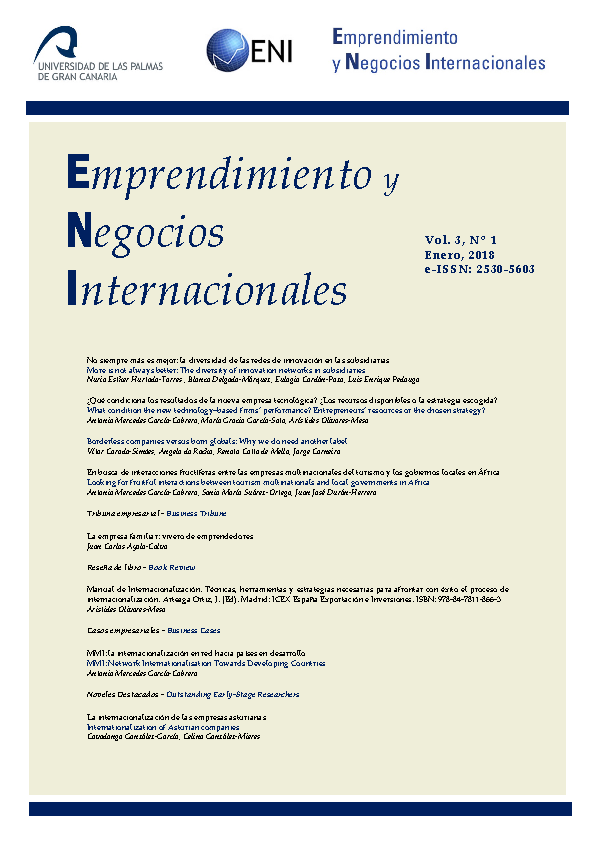¿Qué condiciona los resultados de la nueva empresa tecnológica? ¿Los recursos disponibles o la estrategia escogida? / What condition the new technology–based firms’ performance? Entrepreneurs’ resources or the chosen strategy?
Resumen
¿La disponibilidad de recursos humanos y sociales condiciona el rendimiento de las nuevas empresas tecnológicas? ¿Y la estrategia tecnológica elegida por el emprendedor para competir en el mercado? Este estudio encuentra que ni una ni la otra, si se consideran de forma aislada. Los resultados muestran que el rendimiento de la empresa tecnológica depende de la medida en que los recursos del emprendedor permiten ejecutar la estrategia tecnológica elegida o, en otras palabras, del ajuste entre los recursos y la estrategia. Los autores llegan a esta conclusión después de estudiar una muestra de 175 empresas tecnológicas españolas jóvenes.
Does the availability of human and social resources condition a new technology-based venture’s performance? And the technology strategy chosen by the entrepreneur to compete in the market place? This study found out that neither one nor the other, if they are considered in isolation. Results show that the technology-based venture’s performance depends on how well the entrepreneur’s resources allow the chosen technology strategy to be executed, in other words, the fit between the resources and the strategy. The authors reach this conclusion after studying a sample of 175 Spanish new technology-based ventures.
Descargas
Citas
Boulding, W., & Christen, M. (2003). Sustainable pioneering advantage? Profit implications of market entry. Marketing Science, 22(3), 371–392.
Colombo, M.G., & Grilli, L. (2010). On growth drivers of high-tech start-ups: Exploring the role of founders' human capital and venture capital. Journal of Business Venturing, 25, 610–626.
Elfring, T., & Hulsink, W. (2002). Networks in Entrepreneurship: The case of high-technology firms. Small Business Economics, 21, 409–422.
Ndofor, H.A., & Priem, R.L. (2011). Immigrant entrepreneurs, the ethnic enclave strategy and venture performance. Journal of Management, 37, 790–818.
OECD (2001). OECD science, technology and industry scoreboard 2001. Towards a knowledge-based economy, «http://www.oecd-ilibrary.org». Accessed on Feb., 2008.
Oh, C., Cho, Y. & Kim, W. (2015). The effect of a firm’s strategic innovation decisions on its market performance. Technology Analysis & Strategic Management, 27(1), 39–53.
Park, S., & Bae, Z-T. (2004). New venture strategies in a developing country: Identifying a typology and examining growth patterns through case studies. Journal of Business Venturing, 19, 81–105.
Ruiz-Ortega, M.J., & García-Villaverde, P.M. (2010). Technology-oriented new ventures and entry timing. International Journal of Technology Management, 52(1/2), 46–68.
Walsh, S.T., Kirchhoff, B.A. & Newber, S. (2002). Differentiating market strategies for disruptive technology. IEEE Transactions on Engineering Management, 49(4), 341–351.
Zahra, S.A., Korri, J.S., & Yu, J. (2005). Cognition and international entrepreneurship: implications for research on international opportunity recognition and exploitation. International Business Review, 14(2), 129–146.
Zahra, S.A., Nash, S. & Bickford, D.J. (1995). Transforming technological pioneering into competitive advantage. The Academy of Management Executive (1993-2005), 9(1), 17–31.
Descargas
Archivos adicionales
Publicado
Número
Sección
Licencia
Derechos de autor propuestos por Creative Commons
1. Política propuesta para revistas que ofrecen acceso abierto
Aquellos autores/as que tengan publicaciones con esta revista, aceptan los términos siguientes:
- Los autores/as conservarán sus derechos de autor y garantizarán a la revista el derecho de primera publicación de su obra, el cuál estará simultáneamente sujeto a la Licencia de reconocimiento de Creative Commons que permite a terceros compartir la obra siempre que se indique su autor y su primera publicación esta revista.
- Los autores/as podrán adoptar otros acuerdos de licencia no exclusiva de distribución de la versión de la obra publicada (p. ej.: depositarla en un archivo telemático institucional o publicarla en un volumen monográfico) siempre que se indique la publicación inicial en esta revista.
- Se permite y recomienda a los autores/as difundir su obra a través de Internet (p. ej.: en archivos telemáticos institucionales o en su página web) antes y durante el proceso de envío, lo cual puede producir intercambios interesantes y aumentar las citas de la obra publicada. (Véase El efecto del acceso abierto).

